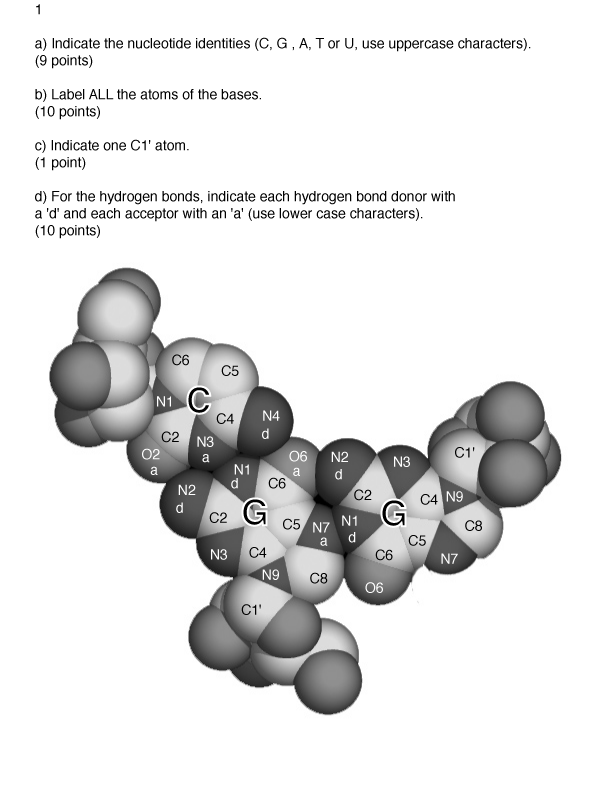Chemistry/Biochemistry 3511 Exam 1
Name _______Key_____________________ Signature ______________________________

2) For the reaction below, if one mole of reactants goes to one mole of products,
would entropy increase of decrease? Explain why in one sentence. (10 points)

The entropy would increase because there are 7 product molecules and only 2 reactant molecules.
The total number of degrees of freedom (rotational and transnational states) is much greater for
the products than for the reactants. Note that we are ignoring heat dissipation effects here (delta S = q/T).
3) List all the types of molecular interactions between molecules in liquid
water. Give a one or two (no more than two) sentence description of each. (25 points total)
(A) Repulsive Interactions.
Overlap of the occupied orbitals of non-bonded atoms results in short-range
(r^12) electrostatic repulsion between the electrons of those atoms. This interaction makes molecules
act like pool balls (hard spheres) with 'van der Waals radii'.
(B) Dipole-Dipole Interactions.
Dipoles, caused by charge separation or atoms with partial charge within a molecule that contains atoms of differential electronegativity,
can be attractive when antiparallel and repulsive when parallel. In water the oxygen carries a partial negative charge
and hydrogen carries a partial positive charge. In addition a dipole can interact can induce a dipoles (always attractive) in an adjacent molecules.
(C) Fluctuating Dipoles (aka London Forces or Dispersive Forces). Whenever any two molecules are
nearby in space they experience coupled fluctuating/oscillating/resonating/time-dependent
dipoles, that cause favorable electrostatic interactions.
(D) Hydrogen Bonding Interactions. An acceptor atom (A) with a basic lone pair of electrons can interact
favorably with a donor atom (D) that bears an acidic proton. Both the acceptor and the donor must be
electronegative. In water D and A are both oxygen atoms.
The terms van der Waals attraction, covalent bond, ionic interaction, charge-charge, and hydrophobic effect
are not correct responses to this question.
4-1) Write out the acid/base reaction of ammonia (NH3) in water.
(10 points)
NH3 + H2O = NH4+ + OH-
or
NH4+ = NH3 + H+
4-2) Explicitly define the pKa of ammonia, using [acid] and [base] notation. (10 points)
The truth is that I intended to ask for the definition of the pKb. This question will not be graded.
But the answer is not difficult:
Ka = [H+][NH3]/[NH4+]
when [NH3] = [NH4+], Ka = [H+] and pKa = pH
True/False Questions (2 points each, 10 points total, 20 points total)
5-1) Enzymes change equilibrium constants. (T/F)
5-2) Enzymes change forward rate constants. (T/F)
5-3) Enzymes change reverse rate constants. (T/F)
5-4) Enzymes stabilize reactants. (T/F)
5-5) Enzymes stabilize products. (T/F)
5-6) Enzyme stabilize transition states. (T/F)
5-7) The concentration of ATP in a cell is around 1 nanomolar. (T/F)
5-8) The concentration of ATP in a cell is around 1 micromolar. (T/F)
5-9) The concentration of ATP in a cell is around 1 millimolar. (T/F)
5-10) Living systems are at equilibrium. (T/F)

